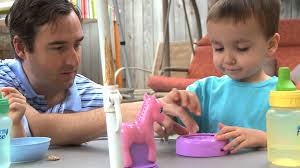Developmental, Individual-Deference, Relationship-Based model (DIR) and Floortime Therapy model are one of the most popular models for helping build healthy foundations in children with learning disabilities. The Floortime therapy model focuses specially on building social, emotional and intellectual skills rather than focusing on isolated skills and behaviors. It was developed by Dr. Stanley Greenspan.

The DIR/Floortime model focuses on speech therapy, occupational therapy and physical therapy involving specific educational programs tailored for children with specific disabilities. It can be described as:
- A method where 20 minutes are spent on parent-child interaction.
- Floortime therapy methods are incorporated into various education programs which include various therapy methods to achieve a set of specific educational goals.

Six Stages of Developmental Milestones in Autism:
- Stage 1: Self-Regulation and Attention: It involves improving and peaking a child’s attention with the help of interactive activities that involve movement, hearing, looking and touching to help improve their attention spans.
- Stage 2: Engagement: In involves developing a sense of engagement with the child to generate a feeling of security, intimacy, empathy and caring to improve their social interactivity.
- Stage 3: Two Way Communication: It involves gaining the child’s attention and interest in various activities and encouraging them to assist you in achieving a particular set of objectives specifically designed to induce the child’s involvement. It helps them gain a sense of fulfillment, thus encouraging them to act on similar tasks on their own or with others’ help.
- Step 4: Problem Solving: It involves building a foundation of problem solving skills to help them get along with their daily activities by walking them through a common task and then encouraging them to do it on their own. It enables them to do things on their own and ask for help if they get struck or do not know what to do next.
- Stage 5: Creating Ideas: It involves encouraging the child to relate to a general sense of life such as gestures, behaviors and conceiving ideas. It is usually achieved by prolonged communication to help them generate feelings and desires of their own.
- Stage 6: Logical Reasoning: It involves encouraging and teaching a child to help in logical thinking, which is essential for separating reality from fantasy by helping them plan, think and connect ideas.
Read More: DIR Model – The Preferred Model for Total Child Development